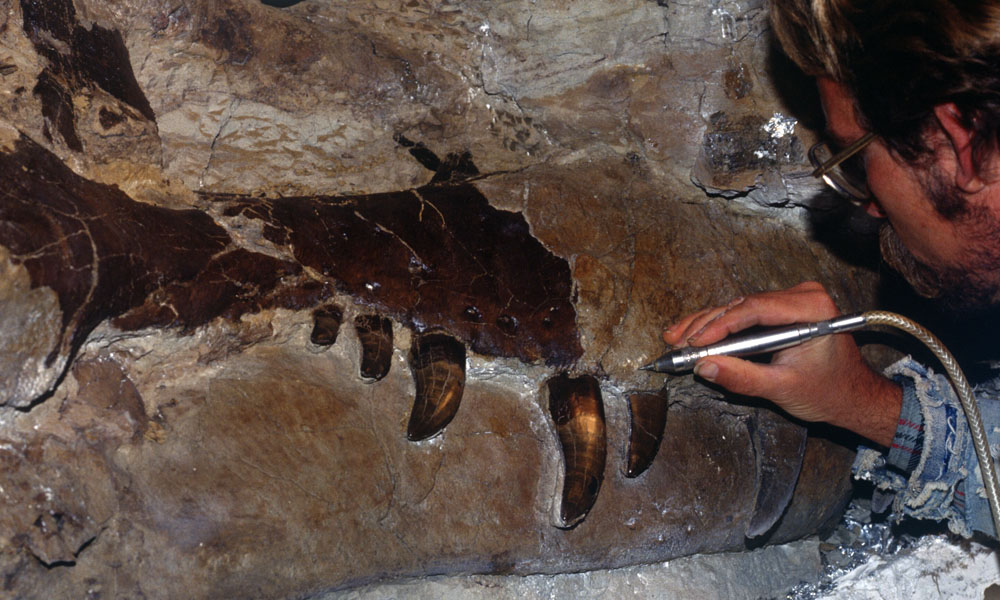Alerts & Newsletters
By providing your information, you agree to our Terms of Use and our Privacy Policy. We use vendors that may also process your information to help provide our services. This site is protected by reCAPTCHA Enterprise and the Google Privacy Policy and Terms of Service apply.
Attention ‘Jurassic World’: Tips from a Paleontologist on Making a Great Dinosaur Movie
Attention 'Jurassic World': Tips from a Paleontologist on Making a Great Dinosaur Movie

The fourth “Jurassic Park” installment, “Jurassic World,” is currently in the works. Luckily an equally riveting dinosaur flick is coming out in theaters tomorrow, and we’ve got a few pointers on how to make a great dino flick from an actual paleontologist.

Peter Larson is one of the main subjects of Todd Douglas Miller’s documentary “Dinosaur 13,” which chronicles the discovery of the largest and most intact Tyrannosaurus Rex skeleton in history. When he and his team from the Black Hills Institute in South Dakota unearthed “Sue,” as she would later be named, they didn’t know that they’d kicked off a 10-year battle with the U.S. government, powerful museums, Native American tribes and competing paleontologists. “Dinosaur 13” comes out in limited theatrical release, On Demand and digital HD August 15. But first, Larson shared a few thoughts with Indiewire on how dinosaurs and science are presented in film and TV.

First of all, have no doubt that his favorite dinosaur film is the first “Jurassic Park.”
“When that came out, for the first time here were living dinosaurs. It was just like a dream come true for the little boy in me that, here you can really see them moving and they were so believable! So it was so inspirational. Actually when you look at the wonder that Grant (Sam Niell) and Laura Dern showed, you know she’s scooping through triceratops poop and all of this. They were not that far off from real people, real paleontologists who would literally do that kind of stuff. I can’t wait to see ‘Jurassic World.'”
And their discovery of “Sue” actually helped improve the film’s accuracy.
“[Paleontologist] Bob Bakker actually helped [Spielberg] out by giving them measurements of Sue’s skeleton. He helped get the proportions right. So that ‘Jurassic Park’ T-Rex is patterned after Sue. Not too many people probably know that.”
But for “Jurassic World” what Larson really wants to see are some feathers.
“Bob Bakker actually drew the first drawing of a dinosaur with feathers back in ’72 or ’73, but we didn’t know at the time ‘Jurassic Park’ came out that, in all probability, every meat-eating dinosaur and these bird-mimic dinosaurs had feathers just like living birds. They’re descendants, of course. We still have dinosaurs with us here today. And whether they lost those feathers as they became very large and didn’t really need them for insulation anymore or whether they retained those feathers throughout their life, the truth was that they had feathers. Tyrannosaurus Rex is more closely related to a hummingbird than it is to a triceratops. If you think about that for a minute, that kind of makes you stop. So I’m hoping, keeping my fingers crossed, that the next ‘Jurassic Park’ comes out with a little different view of those dinosaurs. We know the CGI is going to be good. We know that. Which is fantastic. But I wanna see feathers.”
“Jurassic World” should also strive for more accuracy.
“They should be careful on the various physiological things. For instance, the Camarasaurus in ‘Jurassic Park’ that sneezed onto the poor little girl was chewing the leaves that it was taking off the trees. Those particular dinosaurs did not chew their food. They swallowed it whole.”
But those working on the film shouldn’t be afraid to use their imaginations.
“It’s interesting how in ‘Jurassic Park’ the movie actually foretold science. They foretold the finding of this giant velociraptor because they made the raptors bigger than they were. But we had not yet found a dromaeosaurid that was that big. And now we’ve found them of course! The most fantastic things are out there. It’s ok to use your imagination, but don’t forget what we’ve already learned.”
“It’s interesting how in ‘Jurassic Park’ the movie actually foretold science. They foretold the finding of this giant velociraptor because they made the raptors bigger than they were. But we had not yet found a dromaeosaurid that was that big. And now we’ve found them of course! The most fantastic things are out there. It’s ok to use your imagination, but don’t forget what we’ve already learned.”
Finally take some inspiration from current science TV.
“I think ‘Cosmos‘ is the best thing that’s happened to science TV since Carl Sagan was born. I so love that. I think science programs have suffered somewhat…hopefully it will get back to more science and less creative emotions.”
“I think ‘Cosmos‘ is the best thing that’s happened to science TV since Carl Sagan was born. I so love that. I think science programs have suffered somewhat…hopefully it will get back to more science and less creative emotions.”
Daily Headlines
Daily Headlines covering Film, TV and more.
More from IndieWire
teen terrors
fact vs fiction
Hello Dad Hello Mom
Daily Headlines
Daily Headlines covering Film, TV and more.
By providing your information, you agree to our Terms of Use and our Privacy Policy. We use vendors that may also process your information to help provide our services. This site is protected by reCAPTCHA Enterprise and the Google Privacy Policy and Terms of Service apply.
Most Popular
3.
You may also like
IndieWire is a part of Penske Media Corporation. © 2024 IndieWire Media, LLC. All Rights Reserved.
















